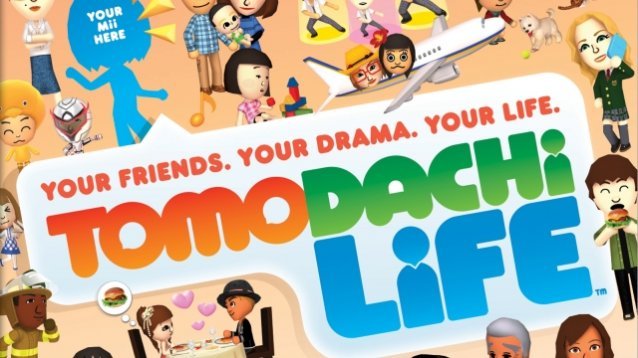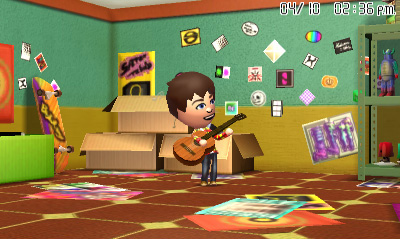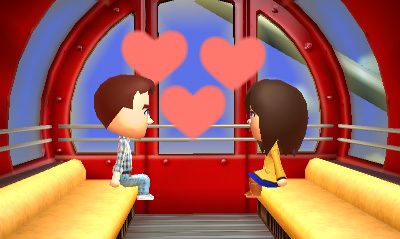
I really had no clue what to expect when I played Tomodachi Life: Move-In Version. Nintendo has been disseminating the demo (seemingly) at random to Platinum-status Club Nintendo members, so I was pleasantly surprised to find a download code in my inbox. Rather than the typical 30 uses normally allotted to 3DS eShop demos, Move-In Version is a limitless, pared-down iteration of the full game. Even after watching the mini Nintendo Direct that detailed Tomodachi Life, I found myself with more questions than answers, so I was stoked to get this opportunity to learn about the title firsthand. I have a feeling I’m not alone in my cluelessness, so sit back and join me as I delve into Move-In Version!
The demo started off by asking me to name the island where the game takes place. It’s not a tropical island, though, but rather a small city with a lone beach sitting in the water. I christened my new getaway Oakland Island (you’re stuck with the word “Island” no matter what name you choose), and from there Move-In asked me to make a duplicate Mii. Either an existing Mii or a new one can be selected, so I pegged the Robert already on my 3DS… and that’s when the hilarity ensued. After assigning a Mii, the demo wanted details like date of birth, favorite color, whether I was a grown-up or a kid, and most importantly, a name. The name, my friends, is where Tomodachi began to assert itself.
Tomodachi Life features a synthetic voice system allowing for in-game speech. Once I typed in my name and proceeded forward, I was shocked to hear my Mii start talking! To be clear, the voice isn’t in any way a true replication of how the player actually sounds. Instead, Nintendo opted for an intentionally digital and semi-robotic sound, instead, and handed customization of it to the player. I spent a few minutes tweaking the pitch and tone of the voice until it sounded close to me, in spirit, and I was chuckling non-stop as I did. It was very reminiscent of the pure joy I felt the first time I made Miis on Wii, as it was entertaining just to make avatars that looked like the people I know. With Move-In, that same whimsical spark is back, as it added another layer of immersion to the experience.

Nintendo also found an ingenious workaround for trickier name pronunciations via a phonetic input option. The game displays your name the way it’s written, but then allows for a phonetic version of it to be keyed in separately in case the computer doesn’t say it right. My last name, Marrujo, is pronounced muh-roo-ho; I typed in Murruho into Move-In, and the computer got it spot on! It’s a small touch, but I think very important for folks to really gel with what Tomodachi is trying to accomplish. With my name in place, Move-In proceeded to ask other questions about me to ascertain my personality. On a sliding scale, I set how fast I moved, how polite I am when speaking, and other traits, which the demo then used to formulate a snapshot of me as a person. It was surprisingly close! In this abbreviated version of Tomodachi Life, players are limited to two other Mii characters who can be made, and I had a blast recreating Angela (my sister and fellow Nintendojo writer!) and one of my friends.
Interestingly, I expected, after making my Mii, to be able to control him directly, but everything actually happens by way of menu screens and tapping the touch screen, instead. At first, I was disappointed, because I initially had visions of Animal Crossing with Miis floating through my mind, but then I started playing, and it clicked. Tomodachi isn’t Animal Crossing, though there are shades of it present, but something more akin to a really goofy, almost surreal Sims. The Miis players create all live in a big apartment, with their own individual residences. Players then go room by room visiting and interacting with each Mii and solving problems for them. Money is used in the game to go and buy the items needed to feed and clothe the Miis, and as problems are resolved, more money is rewarded and the characters level up. This leveling system rewards new items and other perks, like the ability to give the Miis catchphrases to say (oh, the shenanigans of putting words into other people’s mouths!).
Again, not having control over the Miis’ movement seemed disappointing, but there was so much to do that I quickly stopped caring that I couldn’t move around in a traditional way. The island has different buildings and shops to click on, with some open right away, while others are constructed after completing specific criteria in the game. Between choosing different foods to feed my characters (which itself is interesting because not every Mii likes the same thing!), talking with them, and seeing what they’re doing at any given moment, I was enthralled with the wealth of activity taking place. With just three Miis (the full game allows for over 100 to be in the apartment), I was hooked waiting to see what they did next. What’s more, when the full version of the game comes out, I can transfer the Miis from Move-In and get a couple of exclusive panda outfits, as a bonus.

One other thing about the Miis: they start forming relationships with each other. When creating Miis, the player designates how they relate to the main, duplicate Mii. On my island, I listed Angela as a sibling and the other as unrelated (the game is only specific about familial ties). As the characters go about their lives, they can become friends, hate each other, or even fall in love and have a baby! The more of the Miis’ problems that are solved, the more the island grows and expands, and the more the Miis do, too. It’s an interesting system that seems rife with possibilities– possibilities that I can’t wait to check out in the full game. Especially because, as I mentioned earlier, the gameplay is just so darn entertaining and funny!
I was having a great time watching my Miis roll around on the floor of their apartments for no reason, or aimlessly dig holes in the sand at the beach. The animations aren’t anything beyond what other Mii-centric titles have featured over the years, but the personality and expressiveness is unlike anything yet seen with Nintendo’s lovable creations. Nintendo’s localization team is second to no one, as the quirkiness of the Miis, including the bombastic dialogue, is so perfectly conveyed here. While this isn’t a game that everyone will love, I think that fans of Animals Crossing, The Sims, and other offbeat titles should be excited for Tomodachi‘s release. The demo gave just enough to let me know what to expect when the full game releases, but also left me wanting way more. The handful of things I got to do just got me wondering what else to expect, and I look forward to sharing my thoughts on Tomodachi Life when it releases in a couple of weeks on June 6!




 ShareThis
ShareThis






